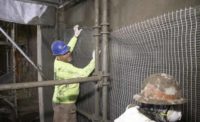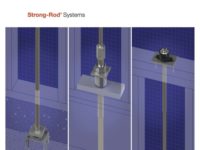Simpson Strong-Tie Wins Award for Seismic Retrofitting

Simpson Strong-Tie, as part of a collaborative reconstruction, seismic retrofitting, and historic restoration project team, has been awarded a 2019 Preservation Design Award for Restoration from the California Preservation Foundation for the restoration of the Napa County Courthouse, which was critically damaged by the South Napa earthquake on April 14, 2014.
Registering 6.0 on the moment magnitude scale, the South Napa earthquake was the strongest to hit the San Francisco Bay Area since the 1989 Loma Prieta earthquake. In addition to damaging the plaster finishes, HVAC, and finish carpentry, the earthquake caused significant structural damage to the courthouse’s existing unreinforced masonry walls.
Repairs and seismic retrofitting on the courthouse began in 2017, conducted by a team including AECOM as the project and construction manager, Carey & Company (now TreanorHL) as the historic architect, ZFA Structural Engineers, and TLCD Architecture. Simpson Strong-Tie participated in or served as an advisor on various aspects of the restoration.
Although several construction methods were considered for the repair of the courthouse structure, concrete masonry unit (CMU) walls were rebuilt to replace the most heavily damaged masonry walls, while fabric-reinforced cementitious matrix (FRCM) technology was selected instead of more traditional repointing and grout injection as a repair solution for the less damaged walls with their countless small cracks.
“FRCM systems are currently being introduced in the structural repair and rehabilitation industry as a new, effective strengthening technology offering reduced thickness, excellent durability, superior performance in high temperatures, and ease of installation versus traditional strengthening and repair methods,” says Aniket Borwankar, a field engineer for Simpson Strong-Tie who participated in the Napa County Courthouse retrofit. “Since FRCM systems add less weight to the structure, they provide an excellent solution for strengthening concrete and masonry substrates, particularly in seismic retrofit applications.”
FRCM systems also have a four-hour UL fire rating and are widely recognized for their ability to withstand high temperatures, a critical consideration in California, where wildfires continue to threaten structures and property. In October 2018, the Atlas fire burned to within a mile of the historic courthouse while reconstruction was still underway. Repairs were completed shortly thereafter, and the grand reopening took place January 22, 2019.
California Preservation Foundation Preservation Design Award recipients are selected by a jury of top professionals in the fields of architecture, engineering, planning, and history, as well as renowned architecture critics and journalists. In making their decision, the 2019 jury noted the difficulty in updating historic courthouses, stating, “meeting ADA requirements and the specific needs of court construction without destroying the historic rooms is a tough challenge. This is a beautiful project, and the results are really impressive.”
Seismic retrofitting using FRCM shotcrete systems provides engineers with a strong, lighter-weight alternative to using rebar. In addition to seismic retrofits, FRCM systems are ideal for the following applications:
- Strengthening aging, damaged, or overloaded structures
- Repairing and strengthening surfaces in a single application
- Correcting size and layout errors
- Matching existing substrate finishes
- Strengthening or repairing damp substrates, or substrates in harsh environments subject to high temperatures, humidity, abrasion, or ultraviolet (UV) radiation
For more information about the Napa County Courthouse restoration and the 2019 Preservation Design Award, visit the California Preservation Foundation’s award website. For additional information on the use of FRCM in seismic retrofitting and other applications, visit the Simpson Strong-Tie FRCM information page.
Looking for a reprint of this article?
From high-res PDFs to custom plaques, order your copy today!





